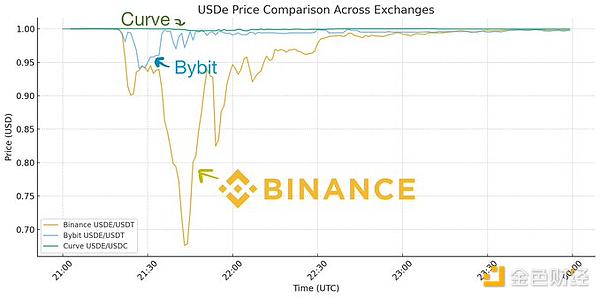Source: Haseeb; Managing Partner at Dragonfly; Compiled by Jinse Finance During last weekend's market volatility, I saw a lot of discussion about USDe decoupling. It was said that USDe briefly decoupled to around 68 cents before recovering. Here's a frequently cited Binance chart: But after digging deeper into the data and speaking with some people over the past few days, it's now clear that this claim is incorrect. USDe has not decoupled at all.
The first thing to understand is that the platform with the most liquidity is not actually an exchange, but Curve. Curve has hundreds of millions of dollars in standing liquidity, while any exchange (including Binance) has only tens of millions of dollars in standing liquidity.
So, if you only look at the chart of USDe on Binance, it looks like a decoupling. But if you overlay USDe's other liquidity platforms, you get a different picture:

Here we see that while USDe fell sharply on every centralized exchange (CEX), its performance was not uniform. Bybit briefly hit $0.95 before quickly recovering, while Binance experienced a frantic decoupling and took a long time to re-peg. Meanwhile, Curve fell only 0.3%. How can we explain this discrepancy? Remember, every exchange was under immense load that day—the largest single liquidation event in cryptocurrency history. Binance was extremely unstable during this period, preventing market makers (MMs) from moving inventory due to API outages, and withdrawals and deposits were blocked. No one was able to intervene and conduct arbitrage. It was like a fire on Binance, but all roads were blocked, preventing firefighters from entering. This caused a wildfire on Binance, but everywhere else, the fire was quickly extinguished through bridged liquidity. (As Ethena founder Guy shows in his post, USDC also temporarily depegged by a few cents on Binance due to the same widespread instability—liquidity couldn't flow in, but this wasn't a depegging event for USDC either.) Okay. Not surprisingly, despite the API instability, prices diverged significantly across exchanges because no one was able to buy in. But why did Binance's drop so much more than Bybit's? There are two answers. First, Binance doesn't have any primary dealer relationships with Ethena, preventing it from minting and redeeming directly on the platform (a feature that Bybit and other exchanges have integrated). This allows market makers to remain on the platform and still perform peg arbitrage. This is significant because otherwise, market makers would have to *take* their money out of Binance, perform Ethereum peg arbitrage, and then bring it back to their inventory. In a crisis with an API outage (and many other currencies plummeting), no one would do that. Second, Binance's oracle performed poorly and began liquidating positions that shouldn't have been liquidated. A good liquidation mechanism wouldn't trigger a flash crash. If you're not the primary exchange for an asset (and Binance isn't the primary exchange for USDe), you should be monitoring prices on the primary exchanges. If you only monitor your own order book, liquidations will be overly aggressive. This led to Binance starting to liquidate USDe as if it were worth around $0.80, triggering a chain reaction. This largely explains why Binance refunded users whose USDe was liquidated (something other exchanges, as far as I know, didn't do)—they screwed up and focused on their own price instead of the true external price. So this was a Binance-specific flash crash, and better market structure could have prevented it. USDe actually remained at its peg all day on its main exchange, Curve. This is completely different from what people are calling a depeg. If you remember USDC during the 2023 banking crisis, this is what the actual decoupling looked like: During the banking crisis, USDC's trading price plummeted across all platforms. There was no place to buy USDC for $1. Redemptions were effectively suspended, so $0.87 was the true price. This is what "decoupling" means. And this time, it's a Binance-specific decoupling. This is a big lesson for market infrastructure, but understanding the nuances is crucial if you want to infer anything from the USDe mechanics of this past weekend.
Throughout the crisis, USDe remained fully collateralized at $1 on its main platform, and in fact increased its backing collateral over the weekend due to price volatility. That being said, this market instability was ultimately a good thing as it provided lessons for the entire industry. Guy's post lays out how any exchange, including Binance, can avoid such issues in the future.
In short: USDe itself was not depegged, it was USDe on Binance that was depegged.
 JinseFinance
JinseFinance
 JinseFinance
JinseFinance JinseFinance
JinseFinance Coinlive
Coinlive  Coindesk
Coindesk Bitcoinist
Bitcoinist Cointelegraph
Cointelegraph Bitcoinist
Bitcoinist Bitcoinist
Bitcoinist Cointelegraph
Cointelegraph 链向资讯
链向资讯